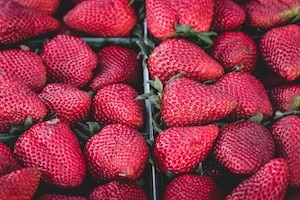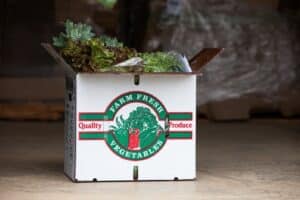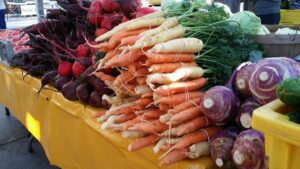2,430; 1,744; and 1,264: That’s how many miles the average head of lettuce, tray of tomatoes and bunch of greens, respectively, travel to get to your plate—that is, unless you eat local. “Eat local” means different things to different people, as there’s no standard definition. Local might mean something grown or produced in Kentucky or Ohio or it might mean something from within 100 miles of your home.
In these newsletters, Mac Stone writes often about the importance of organic agriculture. We often gloss over the importance of local agriculture because it’s implied—we’re local; you’re local. But l have a particular fondness for the localness of Kentucky. I’ve done quite a lot of traveling around the world, working on farms and learning about agriculture and food systems, but I keep coming back here. I assure you, it’s not because we have some of the largest Kroger grocery stores or because Papa John’s decided to debut its organic pizza toppings here. It’s because we have miles upon miles of wood-plank and stone fences lining our back roads, a strong independent-business scene, great bluegrass music and a local-foods movement that rivals many more-metropolitan areas. What’s great about Kentucky is the local flavor—and I mean that in terms of food as much as culture.
Whether you grew up here or you just moved in, you might agree that this region has something special. You might also agree that we can all help keep it that way.

My decision to eat a largely local diet stems from less fossil fuels being put into my food’s transportation, knowing and supporting my farmers, the higher nutritional value and longer shelf life of freshly harvested produce, and the lack of taste in shipped produce. Larger than that, eating locally produced foods is something I can do to help Kentucky keep its local flavor. My views on local food don’t mean I’m not an avocado fiend. I eat grapefruit sometimes. I’ve even been known to purchase organic Michigan apples from Good Foods Co-op. I balance this with a strong commitment to preserving produce as it comes into season and eating meat only from sources I know and agree with.

That local food is “expensive” is an argument I often hear. While I can’t say that’s never true, it’s not always true—and I’m even going to say it’s often not true. Almost reflexively, I compare prices at the farmers market to grocery-store prices. We’re not far apart. Sometimes I find local-foods prices to be on the lower side, even.
I do not take for granted that I have access to what I believe is the best food in the world as an Elmwood Stock Farm employee. If anything, I might be more mindful of and, certainly, grateful for my access to this food because I understand the planning, toil and expense that go into it. I’m not a 24/7 farm employee like Elmwood’s unfailingly dedicated farmers—Ann, Mac, Cecil and John—but I tell you, the price you pay for that bunch of beets is nothing compared to what it took to get them to you.
Take money out of the picture, consider every item of produce and meat that Elmwood sells is certified organic, and try to calculate the intrinsic value of this means of farming: stewardship of the land; the health of farmworkers and consumers; the economic benefit to both the farm and the community; the fact that this is 550 acres of very valuable Central Kentucky land that’s not being developed because it’s instead providing employment and wholesome food. Now put money back in the picture: If you put a dollar value on each one of those items, I would agree with the expensive argument, because local foods would become astronomically pricey.
It doesn’t surprise me when someone says he knows he should support local foods but doesn’t know where to begin. I don’t need to tell you that, as a society, we are overworked and under-cared-for. Of course people reach for fast food, prepackaged food and home-delivered meals, even though they know it’s to a detriment to their health.
Eating local requires a shift in thinking, but it might not be as difficult as you think to have easy access to this food.

Mac’s already told you about how a CSA share benefits you and the farm, so I’m just going to summarize this by saying you don’t have to shop for your produce, meats and eggs every week—a CSA delivers them for you. You’re introduced to truly seasonal eating and aren’t left hanging with all that food, as newsletter recipes and articles (also a Pinterest page with recipes!) help you get the most out of your CSA experience. A CSA offers local foods at a fair price, and a University of Kentucky study found it offers health benefits, too.

Take a farm tour: If you’re skeptical of the whole local-eating thing, take a tour of the farm. Mac is leading From the Ground Up farm tours this spring, summer and fall. The dates and details will be released soon—keep reading this newsletter and check our Facebook page! There’s no replacement for seeing for yourself how foods are produced locally and organically. I’m not exaggerating to say you’ll never look at a head of lettuce the same way.
If you share any of this local-eating responsibility, I ask you to consider four things:
1. What if we showed as much pride in our food production—truly some of the best local-scale food production I’ve experienced in the world—as we do in our sports teams? (Go Big Kale!)
2. What if 10 percent of Lexingtonians’ and Louisvillians’ food budgets went toward local-food purchases? (That’s more than $200 million per year in each city’s farmers’ and food producers’ pockets.)
3. What if just 10 percent of people in Cincinnati’s nine-county metro area did the same? (How about $49 million!)
4. How can we work together to make these things happen? (Go to Facebook to tell us your ideas!)
Buying local has no small effect on you, our community or our farmers. Everyone at the farm certainly appreciates the effort you put into purchasing from Elmwood Stock Farm. Your health appreciates it, too, because whose stomach wants to digest lettuce that’s traveled more than 2,000 miles when it can have lettuce that came from the organic farm next door? —Lisa Munniksma



Made with 
